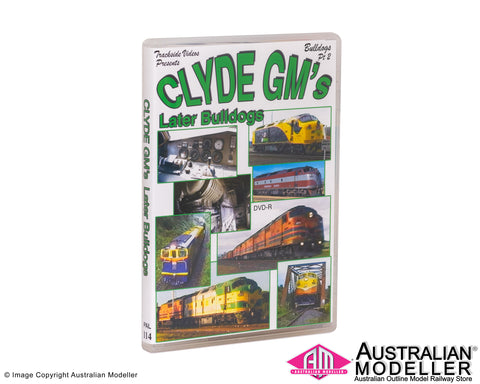Clyde GM’s Early Bulldogs briefly covered Clyde Engineering’s history as a rolling stock manufacturer, its introduction of the Commonwealth Railways (CR) GM Class, Victorian Railways (VR) B Class and New South Wales Government Railways (NSWGR) 42 Class and we saw examples of all the above classes in service post railway privatisation. Clyde GM’s Later Bulldogs traces the introduction of later models in this series.
The NSWGR had been biased towards the Goodwin Alco 44 Class product, largely because it was cheaper to produce, did not require turning at destination for the return journey and had a lower axle loading. With the B Class (double nose) concept shunned, Clyde finally introduced its AJ16C model, essentially the Clyde version of a 44 Class powered with a 567C producing 1800HP for traction and NSWGR ordered 10 in 1965. They were also unique amongst their bulldog brethren in that they were the only bulldogs to have a mechanical engine-driven coolant radiator fan and radiator shutters.
In late 1968 CR, always a loyal Clyde GM customer, ordered five 3000HP locomotives Model AT26C which would become their CL Class. After a successful introduction the order was increased to 17 units. This would be the sunset for bulldog production in Australia, and is believed that CL17 was the last locomotive to be produced in the world with the famous bulldog nose. When Australian National (AN) absorbed CR and South Australian Railways (SAR) the CLs continued in service but by 1993 were in need of major maintenance. As it turned out the major US locomotive rebuilding firm, Morrison Knudsen (MK), had established a small facility at Wyalla and it purchased all 17 of the CLs. An agreement was reached with AN to upgrade their mechanical and electrical equipment, increase their output to 3200HP and long term lease them back to AN. In this agreement, MK were required to break the CLs into two separate classes, 10 in the CLP Class which would have head end power installed in the rear of the locomotive, feature larger fuel tanks to support same and have higher gearing for passenger service; and 7 in the CLF Class not having such features and geared for freight operation.
In this presentation, we will examine the 421, CL, CLP, and CLF bulldogs inside and out and view them in service. We also will travel between Sydney and Lithgow in the cab of the first CLP powered Sydney to Perth Indian Pacific passenger train.
Approximate run time: 105 minutes.

